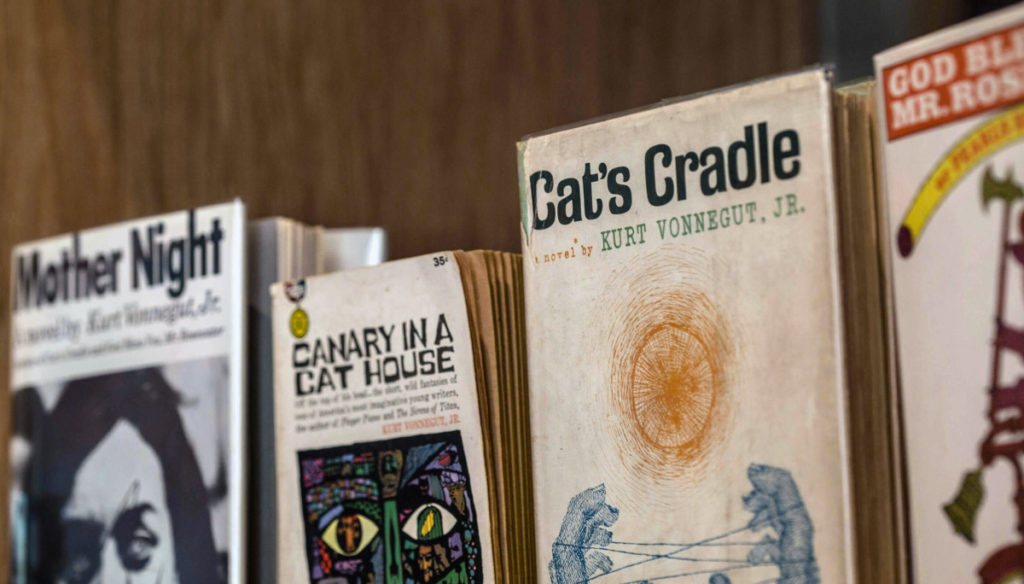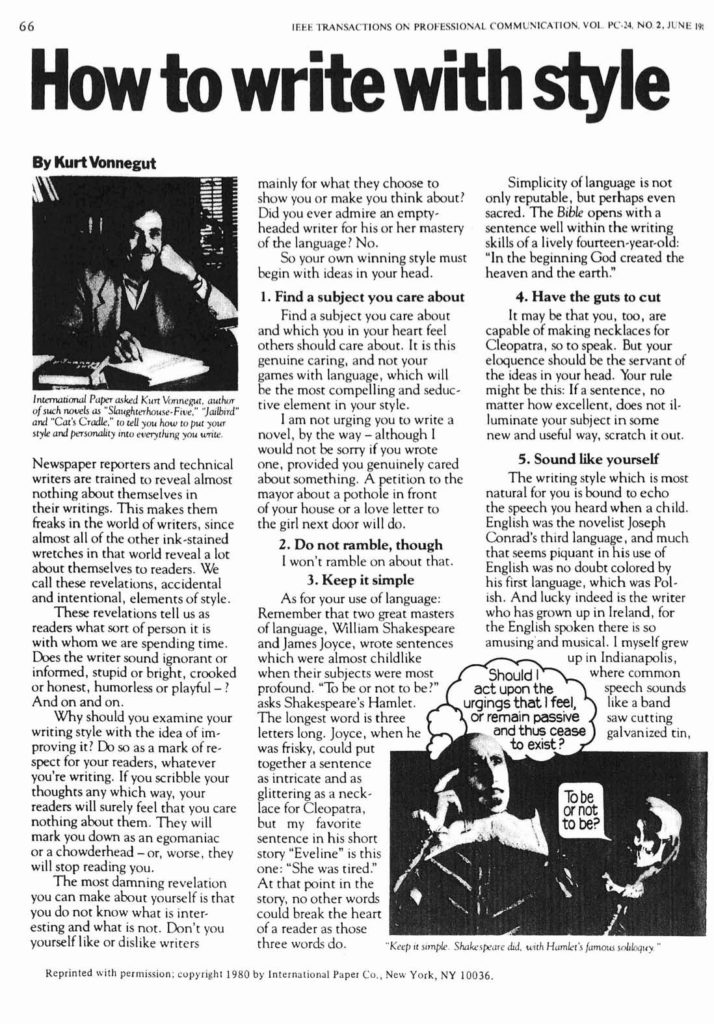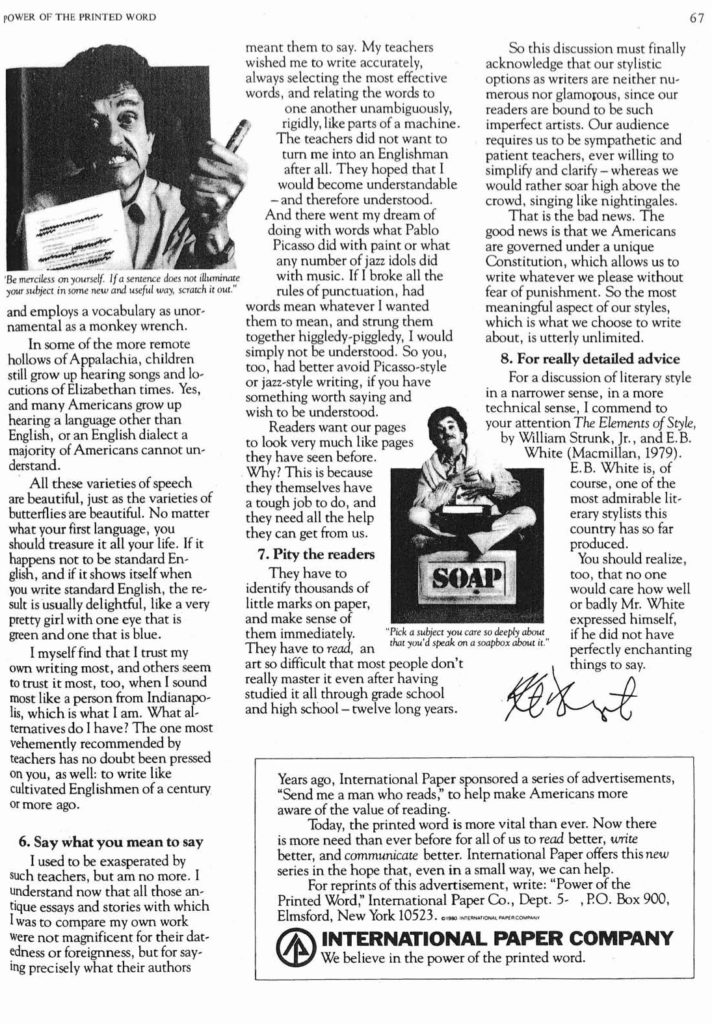
The last place you’d expect to find writing advice is in the Institute of Electrical and Electronics Engineers’ journal Transactions on Professional Communications. Yet, there it was.
In the 1980 issue, Kurt Vonnegut dispatches advice on “how to put your style and personality into everything you write.” What’s even more interesting, is that he does it in an ad, part of a series from the International Paper Company called “The Power of the Printed Word.” It was a ploy, a decree, or call to arms urging all of us to “read better, write better, and communicate better.”
Below you will find that advice, as well as other snippets about writing from the prologues of his novels, interviews, and his memoir of essays, A Man Without a Country.
How to Write with Style: An ad


1. Find a subject you care about
Find a subject you care about and which you in your heart feel others should care about. It is this genuine caring, and not your games with language, which will be the most compelling and seductive element in your style.I am not urging you to write a novel, by the way—although I would not be sorry if you wrote one, provided you genuinely cared about something. A petition to the mayor about a pothole in front of your house or a love letter to the girl next door will do.
2. Do not ramble, though
I won’t ramble on about that.3. Keep it simple
As for your use of language: Remember that two great masters of language, William Shakespeare and James Joyce, wrote sentences which were almost childlike when their subjects were most profound. “To be or not to be?” asks Shakespeare’s Hamlet. The longest word is three letters long. Joyce, when he was frisky, could put together a sentence as intricate and as glittering as a necklace for Cleopatra, but my favorite sentence in his short story “Eveline” is this one: “She was tired.” At that point in the story, no other words could break the heart of a reader as those three words do.
Simplicity of language is not onlyreputable, but perhaps even sacred. The Bible opens with a sentence well within the writing skills of a lively fourteen-year-old: “In thebeginning God created the heaven and the earth.”4. Have guts to cut
It may be that you, too, are capable of making necklaces for Cleopatra, so to speak. But your eloquence should be the servant of the ideas in your head. Your rule might be this: If a sentence, no matter how excellent, does not illuminate your subject in some new and useful way, scratch it out.5. Sound like yourself
The writing style which is most natural for you is bound to echo the speech you heard when a child. English was Conrad’s third language, and much that seems piquant in his use of English was no doubt colored by his first language, which was Polish. And lucky indeed is the writer who has grown up in Ireland, for the English spokenthere is so amusing and musical. I myself grew up in Indianapolis, where common speech sounds like a band saw cutting galvanized tin, and employs a vocabulary as unornamental as a monkey wrench.In some of the more remote hollows of Appalachia, children still grow up hearing songs and
locutions of Elizabethan times. Yes, and many Americans grow up hearing a language other than English, or an English dialect a majority of Americans cannot understand.All these varieties of speech are beautiful, just as the varieties of butterflies are beautiful. No matter what your first language, you should treasure it all your life. If it happens to not be standard English, and if it shows itself when your write standard English, the result is usually delightful, like a very pretty girl with one eye that is green and one that is blue.
I myself find that I trust my own writing most, and others seem to trust it most, too, when I sound most like a person from Indianapolis, which is what I am. What alternatives do I have? The one most vehemently recommended by teachers has no doubt been pressed on you, as well: to write like cultivated Englishmen of a century or more ago.
6. Say what you mean
I used to be exasperated by such teachers, but am no more. I understand now that all those antique essays and stories with which I was to compare my own work were not magnificent for their datedness or foreignness, but for saying precisely what their authors meant them to say. My teachers wished me to write accurately, always selecting the most effective words, and relating the words to one another unambiguously, rigidly, like parts of a machine. The teachers did not want to turn me into an Englishman after all. They hoped that I would become understandable—and therefore understood. And there went my dream of doing with words what Pablo Picasso did with paint or what any number of jazz idols did with music. If I broke all the rules of punctuation, had words mean whatever I wanted them to mean, and strung them together higgledy-piggledy, I would simply not be understood. So you, too, had better avoid Picasso-style or jazz-style writing, if you have something worth saying and wish to be understood.Readers want our pages to look very much like pages they have seen before. Why? This is because they themselves have a tough job to do, and they need all the help they can get from us.
7. Pity the readers
They have to identify thousands of little marks onpaper, and make sense of them immediately. They have to read, an art so difficult that most people don’t really master it even after having studied it all through grade school and high school—twelve long years.So this discussion must finally acknowledge that our stylistic options as writers are neither numerous nor
glamorous, since our readers are bound to be such imperfect artists. Our audience requires us to be sympathetic and patient readers, ever willing to simplify and clarify—whereas we would rather soar high above the crowd, singing like nightingales.That is
the bad news. The good news is that we Americans are governed under a unique Constitution, which allows us to write whatever we please without fear of punishment. So the most meaningful aspect of our styles, which is what we choose to write about, is utterly unlimited.8. For really detailed advice
For a discussion of literary style in a narrower sense, in a more technical sense, I recommend to your attention The Elements of Style, by William Strunk, Jr. and E.B. White. E.B. White is, of course, one of the most admirable literary stylists this country has so far produced.You should realize, too, that no one would care how well or badly Mr. White expressed
—How to Write With Style, published in the Institute of Electrical and Electronics Engineers’ journal Transactions on Professional Communications in 1980.himself, if he did not have perfectly enchanting things to say.

Construct Short Stories with Purpose
Kurt Vonnegut’s rules for writing short stories from the intro to Bogombo Snuffbox:
1. Use the time of a total stranger in such a way that he or she will not feel the time was wasted.
2. Give the reader at least one character he or she can root for.
3. Every character should want something, even if it is only a glass of water.
4. Every sentence must do one of two things—reveal character or advance the action.
5. Start as close to the end as possible.
6. Be a Sadist. No matter how sweet and innocent your leading characters, make awful things happen to them – in order that the reader may see what they are made of.
7. Write to please just one person. If you open a window and make love to the world, so to speak, your story will get pneumonia.
8. Give your readers as much information as possible as soon as possible. To hell with suspense. Readers should have such complete understanding of what is going on, where and why, that they could finish the story themselves, should cockroaches eat the last few pages.
The greatest American short story writer of my generation was Flannery O’Connor (1925-1964). She broke practically every one of my rules but the first. Great writers tend to do that.
Brian Collins at The Writing Cooperative did a great write up on each rule and what they mean.

Have Other Interests
I think it can be tremendously refreshing if a creator of literature has something on his mind other than the history of literature so far. Literature should not disappear up its own asshole, so to speak.
—“An interview conducted with himself, by himself,” for The Paris Review

Art for Art’s Sake
If you want to really hurt your parents, and you don’t have the nerve to be gay, the least you can do is go into the arts. I’m not kidding. The arts are not a way to make a living. They are a very human way of making life more bearable. Practicing an art, no matter how well or badly, is a way to make your soul grow, for heaven’s sake. Sing in the shower. Dance to the radio. Tell stories. Write a poem to a friend, even a lousy poem. Do it as well as you
—A Man Without a Countrypossible can. You will get an enormous reward. You will have created something.
I used to teach a writer’s workshop at the University of Iowa back in the 1960s, and I would say at the start of every semester, “The role model for this course is Vincent van Gogh—who sold two paintings to his brother.” (Laughs.) I just sit and wait to see what’s inside me, and that’s the case for writing or for drawing, and then out it comes. There are times when nothing comes. James Brooks, the fine abstract-expressionist, I asked him what painting was like for him, and he said, “I put the first stroke on the canvas and then the canvas has to do half the work.” That’s how serious painters are. They’re waiting for the canvas to do half the work. (Laughs.) Come on. Wake up.
—The Last Interview

The Shapes of Stories

Loosen Up
I don’t have the will to teach anymore. I only know the theory… It was stated by Paul Engle—the founder of the Writers Workshop at Iowa. He told me that, if the workshop ever got a building of its own, these words should be inscribed over the entrance: “Don’t take it all so seriously.”
—“An interview conducted with himself, by himself,” for The Paris Review

Confronting Plot
I guarantee you that no modern story scheme, even plotlessness, will give a reader genuine satisfaction, unless one of those old-fashioned plots is smuggled in somewhere. I don’t praise plots as accurate representations of life, but as ways to keep readers reading. When I used to teach creative writing, I would tell the students to make their characters want something right away—even if it’s only a glass of water. Characters paralyzed by the meaninglessness of modern life still have to drink water from time to time. One of my students wrote a story about a nun who got a piece of dental floss stuck between her lower left molars, and who couldn’t get it out all day long. I thought that was wonderful. The story dealt with issues a lot more important than dental floss, but what kept readers going was anxiety about when the dental floss would finally be removed. Nobody could read that story without fishing around in his mouth with a finger. Now, there’s an admirable practical joke for you. When you exclude plot, when you exclude anyone’s wanting anything, you exclude the reader, which is a mean-spirited thing to do. You can also exclude the reader by not telling him immediately where the story is taking place, and who the people are [and what they want].
And you can put him to sleep by never having characters confront each other. Students like to say that they stage no confrontations because people avoid confrontations in modern life. “Modern life is so lonely,” they say. This is laziness. It’s the writer’s job to stage confrontations, so the characters will say surprising and revealing things, and educate and entertain us all. If a writer can’t or won’t do that, he should withdraw from the trade.
—“An interview conducted with himself, by himself,” for The Paris Review

Tread Lightly with Love Lest You Lose
So much of what happens in storytelling is mechanical, has to do with the technical problems of how to make a story work. Cowboy stories and policeman stories end in shoot-outs, for example, because shoot-outs are the most reliable mechanisms for making such stories end. There is nothing like death to say what is always such an artificial thing to say: “The end.” I try to keep deep love out of my stories because, once that particular subject comes up, it is almost impossible to talk about anything else. Readers don’t want to hear about anything else. They go gaga about love. If a lover in a story wins his true love, that’s the end of the tale, even if World War III is about to begin, and the sky is black with flying saucers.
—“An interview conducted with himself, by himself,” for The Paris Review

Don’t Light the Candle in your Ass
I get up at 7:30 and work four hours a day. Nine to twelve in the morning, five to six in the evening. Businessmen would achieve better results if they studied human metabolism. No one works well eight hours a day. No one ought to work more than four hours.
—An interview with Robert Taylor in Boston Globe Magazine, 1969

Learn the Rules, then Break Them
Here is a lesson in creative writing. First rule: Do not use semicolons. They are transvestite hermaphrodites representing absolutely nothing. All they do is show you’ve been to college.
[Then, later in his book …]
Those of us who had imagination circuits build can look in someone’s face and see stories there; to everyone else, a face will just be a face.
And there, I’ve just used a semi-colon, which at the outset I told you never to use. It is to make a point that I did it. The point is: Rules only take us so far, even good rules.
—A Man Without a Country